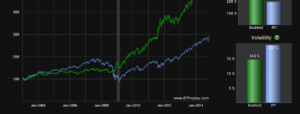Food stocks can often make excellent long-term dividend growth investments, thanks to the highly defensive nature of their businesses. After all, everyone has to eat no matter what the economy or interest rates are doing.
This is why many well-known food blue chips are among the list of dividend aristocrats and dividend kings, which have track records of 25+ and 50+ years of consecutive annual dividend growth, respectively.
Among food stocks, B&G Foods’ (BGS) 4.6% yield is one the highest dividends you can find. Even better, the company has grown its dividend at a double-digit pace in recent years and has potential for 7% to 8% annual dividend growth going forward.
However, in order to know whether B&G Foods is worthy of adding to your portfolio, especially if you’re a low risk investor looking to live off dividends during retirement, we need to get comfortable with B&G Foods’ business quality, current valuation, and the safety of its dividend.
Business Description
B&G Foods, including its predecessors, has been in business for more than 125 years. The company is the producer and marketer of numerous shelf-stable food products under dozens of independent, niche brands such as: Cream of Rice, Cream of Wheat, Don Pepino, Mrs. Dash, Ortega, Pirate’s Booty, and Green Giant.
The company’s many food brands have been steadily accumulated over time, including several recent acquisitions:
Business Analysis
The packaged food business is increasingly a tough one in which to build a durable competitive advantage, otherwise known as a moat. That’s especially true in today’s environment in which consumers are shifting their buying habits from packaged foods and towards fresh foods, especially of the organic variety. Many large brands are seeing their dominant market share positions gradually erode.
Packaged food brands are also facing increasing competition from generic store brands that make it hard to pass any increased production costs onto consumers. This means that the closest packaged food companies can come to a moat is maximizing economies of scale in order to cut costs and optimize their margins and returns on capital.
However, despite the challenges in the industry, in which most blue chip names such as General Mills, Hormel Foods (HRL), and Kellogg (K) are struggling with falling or flat sales, B&G has proven its long-term ability to buck the trend with very strong revenue, earnings, and free cash flow (FCF) growth.

Source: Simply Safe Dividends
Of course, that’s not because any of B&G’s brands have necessarily seen strong growth. Instead, the company continues to acquire new, under-loved brands at an impressive rate with a goal of investing more in marketing and new product development to reinvigorate them.
However, management’s track record of generating organic growth is mixed at best. For example, in the most recent quarter B&G Foods’ base business, meaning those brands it’s owned for at least a year, saw sales decline by 2.4%. Volume declined by 2.8%, but reported sales growth was helped by a price increase of 0.2% and beneficial currency effects of 0.2%.
In fact, just over half of B&G’s brands saw sales declines which management partially blamed for warmer-than-expected winter weather. Of course, the true reason is more likely the longer-term secular decline in packaged foods that numerous other companies have been experiencing for years.
However, just because B&G isn’t immune from flat to slightly falling sales doesn’t necessarily mean that it might not be a reasonable long-term investment. After all, with numerous acquisitions comes the potential for synergistic cost savings, in addition to growing economies of scale that can help B&G maintain strong and gradually improving margins over time.













Leave A Comment